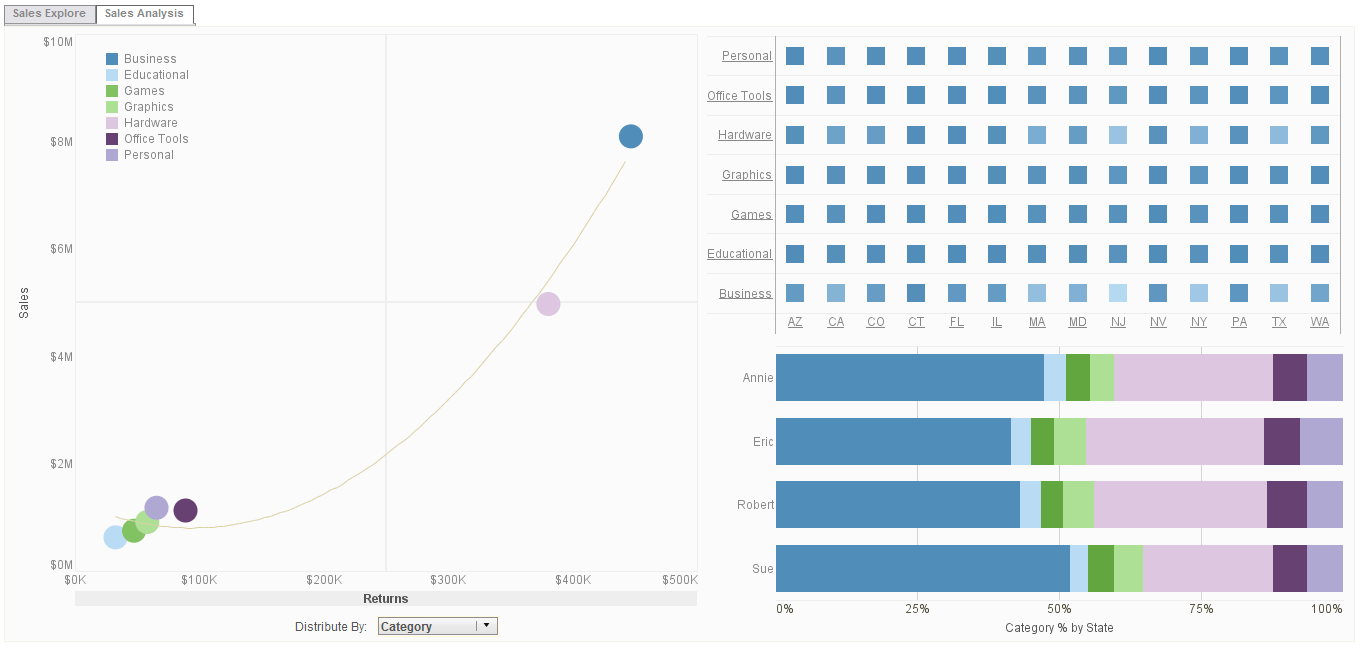Which OLAP Tool to Use?
Below is the transcript of the webinar hosted by InetSoft on the topic of OLAP, the basics of what it is and an explanation of some of the technology terms related to, what OLAP's benefits are, and what the choices in OLAP technologies and OLAP tools are. The speaker is Mark Flaherty, CMO at InetSoft.
What is OLAP Data Analysis?
Mark Flaherty (MF): If you look at the formal definition of OLAP data analysis, it is really the studying of the nature of something or determining its essential features and their relations. In the context of business intelligence, analysis’s definition is around summarization, or statistical drill-into-detail data exploration.
In some cases you’re answering a question. In other cases you’re projecting into the future.
Often we see a lot of users using analysis as a starting point for reporting. So they have a couple of questions in mind, or general ideas someone gave them. Now they’re looking to identify a potential specific question and need a way to explore data.
Once they have their formal question formulated, and then find the answer they are looking for, that’s when they get into formatting and report design layout, et cetera.
| #1 Ranking: Read how InetSoft was rated #1 for user adoption in G2's user survey-based index | Read More |
Tools That Are Very Analytical
Often tools that are very analytical have a lot of interactivity, visualization and navigation. That’s a big requirement for many users who need to interact with data using a GUI or some sort of interface that allows them to explore and identify trends.
One of the most common things that we see is that data analysis tools are usually used by a select few people. Over time we are starting to see that trend slowly change where more people in a company can and do use these OLAP tools, but for the most part we’re still seeing specific roles in an organization that have specific needs with regards to data analysis.
Are OLAP Tools Still Used?
Yes, OLAP (Online Analytical Processing) tools are still widely used in the business intelligence and analytics space. OLAP provides a multidimensional view of data, allowing users to interactively analyze and explore complex datasets. OLAP tools are particularly valuable for decision-makers and analysts who need to perform in-depth analysis, trend identification, and "slice and dice" operations on large datasets.
OLAP tools support various types, including Multidimensional OLAP (MOLAP), Relational OLAP (ROLAP), and Hybrid OLAP (HOLAP), each with its own strengths and use cases. While newer technologies like in-memory analytics and cloud-based solutions have gained popularity, OLAP tools continue to be relevant, especially in scenarios where the ability to analyze data from multiple dimensions is crucial for business insights.
What Is an Alternative to Using OLAP?
An alternative to using OLAP (Online Analytical Processing) for multidimensional analysis is to leverage in-memory analytics and columnar databases. In-memory analytics involves storing the entire dataset in RAM (Random Access Memory) rather than relying on disk-based storage, allowing for faster query performance and real-time analysis. Columnar databases, on the other hand, store data in columns rather than rows, optimizing query efficiency for analytics workloads.
Additionally, NoSQL databases and big data technologies like Apache Spark can be alternatives, especially when dealing with massive volumes of unstructured or semi-structured data. These technologies provide distributed and scalable processing capabilities, allowing for efficient analysis of large datasets.
Cloud-based analytics platforms and services also offer alternatives to traditional OLAP systems. These platforms often provide scalable and flexible solutions with built-in analytics capabilities, eliminating the need for organizations to manage and maintain their own infrastructure.
Graph databases are another alternative, suitable for scenarios where relationships and connections between data points are crucial. They excel in handling complex relationships and are often used in social network analysis, fraud detection, and other applications where understanding connections is essential.
What Skills Are Necessary to Use OLAP Tools?
To effectively use OLAP (Online Analytical Processing) tools, individuals need a combination of technical and analytical skills. Here is a list of skills necessary for working with OLAP tools:
- Data Analysis: Understanding of analytical concepts and the ability to interpret and derive meaningful insights from data.
- Database Management: Proficiency in working with databases, as OLAP tools often rely on querying and manipulating data stored in relational or multidimensional databases.
- SQL (Structured Query Language): Knowledge of SQL is essential for constructing queries to retrieve and manipulate data in relational databases, which are commonly used as the back-end for OLAP systems.
- OLAP Concepts: Familiarity with OLAP concepts, including dimensions, measures, cubes, and hierarchies. Understanding how to structure and navigate multidimensional data is crucial.
- Data Modeling: Ability to design and create data models that suit the analytical requirements of the business, ensuring efficient storage and retrieval of data.
- ETL (Extract, Transform, Load): Experience with ETL processes to extract data from various sources, transform it to fit the required structure, and load it into the OLAP system.
- Understanding of OLAP Technologies: Knowledge of different OLAP technologies, such as MOLAP (Multidimensional OLAP), ROLAP (Relational OLAP), and HOLAP (Hybrid OLAP), and the ability to choose the appropriate one based on business needs.
- Problem-Solving Skills: Analytical problem-solving skills to address complex data analysis challenges and derive actionable insights.
- Data Visualization: Proficiency in data visualization tools to effectively communicate analytical findings. This skill is essential for presenting results to stakeholders in a clear and understandable manner.
- Communication Skills: Effective communication skills to collaborate with stakeholders, understand business requirements, and convey analytical results in a meaningful way.
- Attention to Detail: Thorough attention to detail is crucial to ensure accuracy in data analysis and reporting.
- Continuous Learning: Given the dynamic nature of technology, a willingness to continuously learn and adapt to new features and improvements in OLAP tools.


